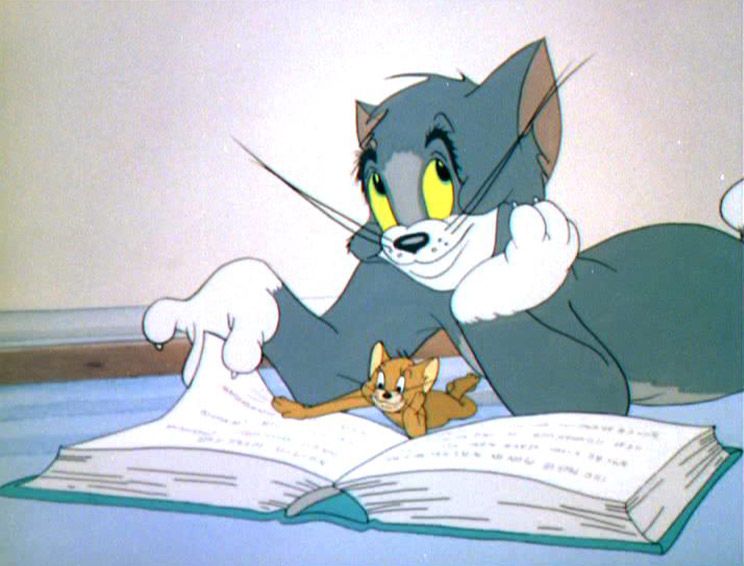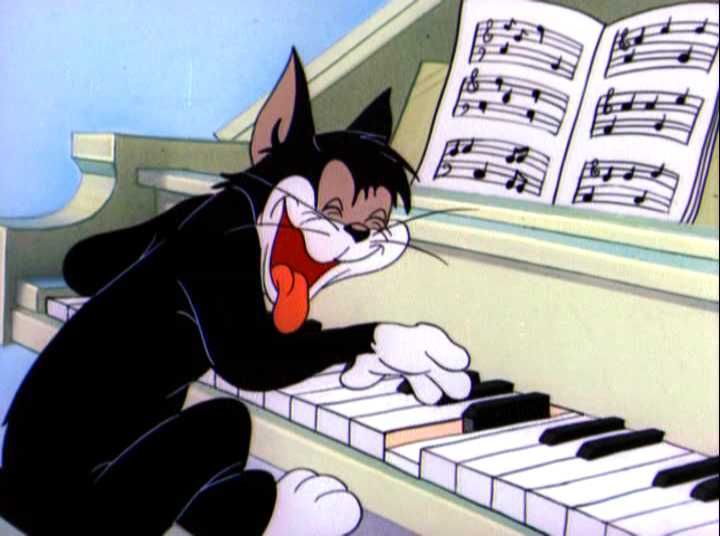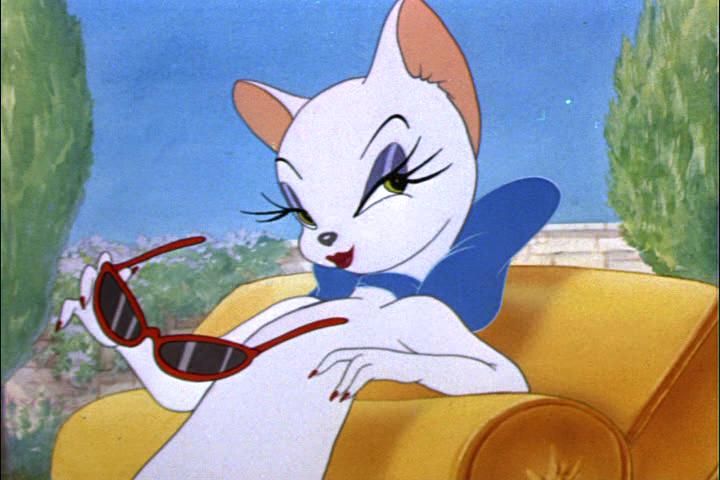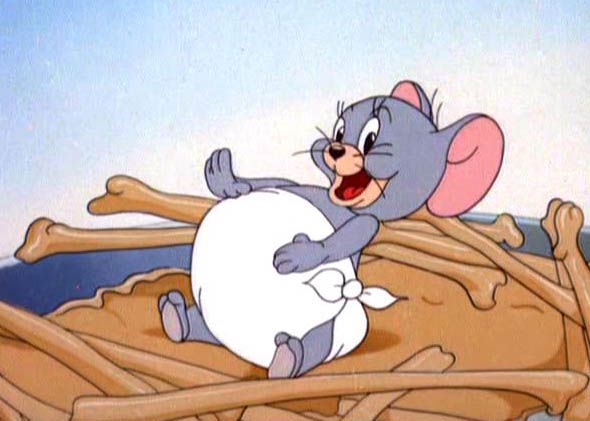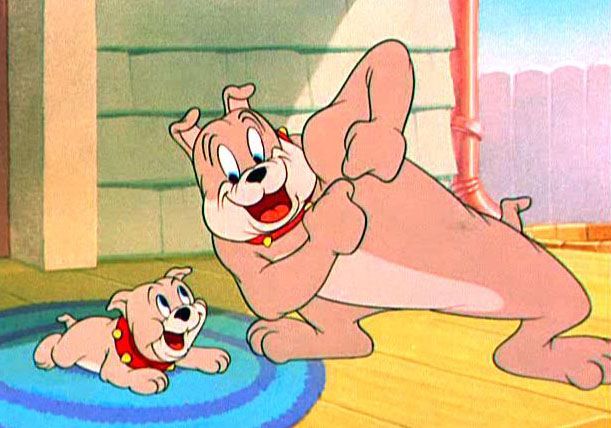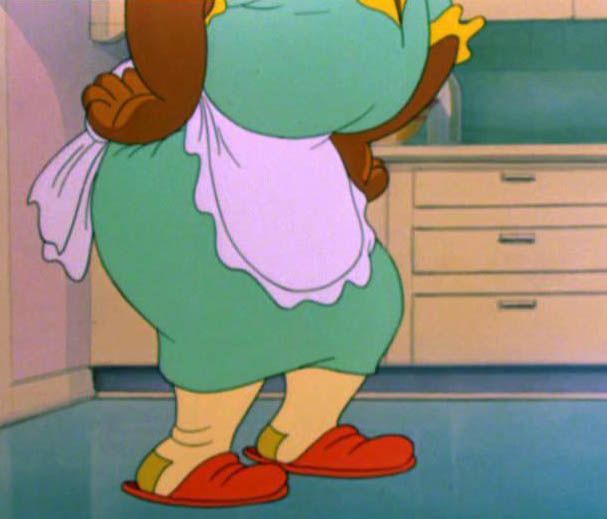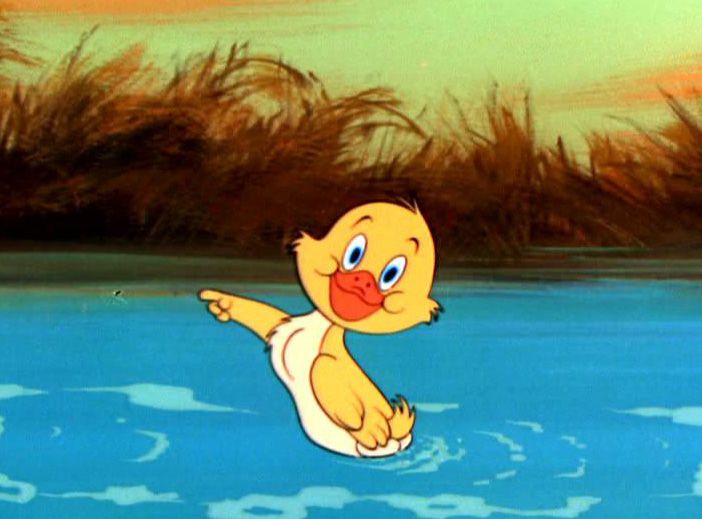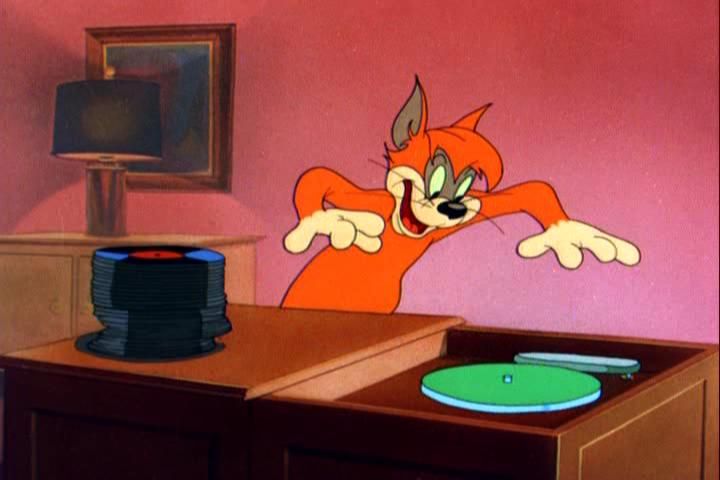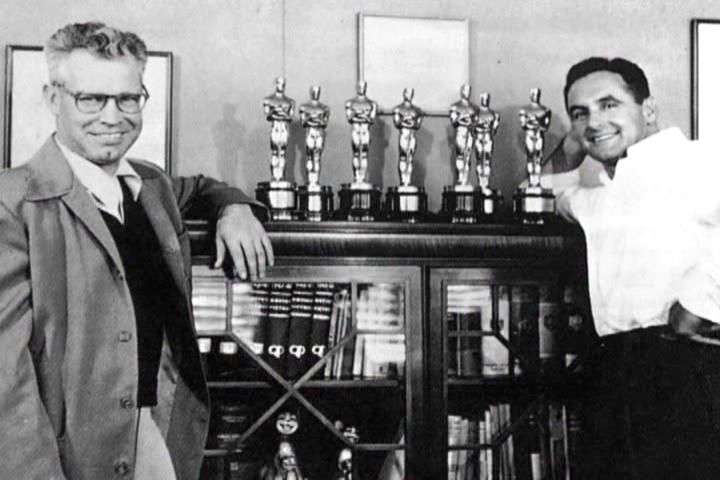Tom ve Jerry`` William Hanna ve Joseph Barbera tarafından yaratılmış kısa filmler serisi halinde bir çizgi filmdir.Tom ve Jerry, MGM stüdyosu tarafından 1940 ile 1957 arasında yayımlanmıştır.
Konusu ve Formatı
Konu genellikle bir olayın üzerinde gelişir.Ev kedisi Tom evin yiyeceğiyle beslenen ve küçük bir yuvada yaşayan Jerry`nin kavgasıdır.Tom her seferinde Jerry`yi avlamaya çalışır ancak hiçbirinde başarılı olmaz ve Jerry akıl oyunlarıyla her zaman galip gelmeyi başarır. Tom`un ise galip geldiği zamanlar oldukça nadirdir. Tom ve Jerry filmlerinde, jerry ve tom sürekli birbirlerine abartılı ve can yakan şakalar yaparlar.Jerry,Tom`un kafasını panjur sıkıştırma,kuyruğunu kapana,elektrik prizine sokma gibi şakalar yapar bunun yanında patlayıcılar,balta,çekiç ve zehir gibi araçları kullanarak Tom`a karşı galip gelmeye çalışır.Tom ise jerry`ye karşı ev araç gereçlerini ve eline geçirdiği her şeyi silah olarak kullanır.Kapan,zehir,ütü,tost makinası gibi.Bunca abartılı kavgalara rağmen ne Tom`a ne de Jerry`ye hiçbir şey olmamakta kan dahi akmamaktadır.Tom ve Jerry filmlerinde aslında insanların kendi aralarındaki günlük çekişmeleri ve anlaşmazlıkları kedi-fare animasyonu benzetmesiyle ve mizahi bir yolla anlatılmasıyla şekillenmiştir.
Filmlerin,diğer bir önemli parçası olan müzikler genelde jazz,pop ve klasik müzikten oluşur.Her türlü duygu ve efekt için çeşitli müzikler eklenmiştir.Tom ve Jerry genellikle birbirleriyle ve diğer karakterlerle sözlü diyaloglara girmezler.Sadece kahkaha,soluk alıp verme gibi sesler duyulur onun dışında her türlü ifade görsel ve işitsel olarak aktarılır.
Karakterler
Tom and Jerry
Tom, mavi-gri renkte,sevilen ve güvenilir bir ev kedisidir,Jerry, Tom ile aynı evi paylaşan küçük kahverengi bir faredir. Tom öfkeli,alıngan ve bir o kadarda sakar bir kedidir.Jerry ise özgür,kurnaz,fırsatçı bir faredir.Çok enerjik ve zeki.Tom`dan daha kıvrak bir zekaya sahiptir.Jerry,Tom ile mücadelesinde genellikle galip gelirken,Tom ise çoğu zaman mağlubiyetten kurtulamaz.Buna rağmen yılmadan usanmadan jerry`yi yakalama planlarına devam eder. Filmlerde diğer karakterler genelde tom ve jerry nin arkadaşları ve sevgilileridir.Tom ve Jerry filmlerde tüm ısrarlara rağmen konuşturulmamıştır.Yalnızca şarkı söylebilmişlerdir.Bunun yanında filmlerde insanlara da yer verilmiştir.Ancak bunlar esas karakterleri daha canlı tutmak için gölge şeklinde yansıtılmıştır.(örn.The Cat Concerto)Diğer karakterler
" target="_blank"> ve oğlu Tyke,Tom ve Jerry filmlerinin başlıca köpek karakterleridir.]Butch
``Butch``,Siyah beyaz renkte bir sokak kedisidir.Jerry`yi yemek için sık sık yakalamaya çalışır.İlk olarak 1943`te Baby Puss adlı kısa filmle dahil olmuştur,genellikle kötü ve uyuz bir kedi olarak gösterilmiştir.Spike
Tom ve Jerry filmlerinin bulldog cinsi bekçi köpeğidir.Tom`un bir numaralı düşmanı Jerry`nin ise sevdiği bir karakterdir.Seslendirmelerini Daws Butler ve Jimmy Durante yapmıştır.Tyke
Spike adlı köpeğin yavrusudur.Her ikiside aynı tarihlerde seriye katılmışlardır.Daha sonra Spike ve Tyke adlı ayrı bir kısa filmde yer almışlardır.Mammy Two Shoes
Evin işleriyle ilgilenen siyahi Amerikan hizmetçisidir.Tom ve Jerry filmlerinde yüzü görünmez(sadece 1950`lerde yayımlanmış Saturday Evening Puss adlı kısa filmde yüzü gösterilmiştir).Tom`u süpürgeyle döver ve genellikle kötü davranır,fareden korktuğu zamanlar sandelyeye çıkar.Karakterin seslendirmesini Lillian Randolph yapmıştır.Tarihi ve Evrimi
Hanna-Barbera dönemi (1940 – 1958)
.] William Hanna ve Joseph Barbera 1930`larda MGM çizgi film stüdyosunda çalışmalırına başladılar.Barbera senaryo ve karakter tasarımıyla ilgilenirken,Hanna da ona eşlik ediyor ve yönetmenliklerini yapıyordu.İlk olarak tüm toplumlarda yer alan kedi fare anlaşmazlığını film yapmayı düşündüler ve Tom ve Jerry serisinin ilk filmi olan ``Puss Gets The Boot`` adlı kısa filmi yaptılar.Bu filmde Jasper adlı ev kedisi evdeki kemirgenleri yakalamaya çalışır ancak başarılı olamadığı gibi evdeki eşyalara zarar vermektedir bunun üzerine evin sahibi tarafından kovulur. Film gösterime sokulmadan önce Hanna ve Barbera`nın bazı endişeleri vardır.Bunlardan en önemlisi "piyasada bu kadar kedi-fare kovalamacasını anlatan film ve animasdyon varken bu film ne kadar tutulurdu?" Tüm bu kötümser düşüncelere rağmen ilk film gösterime girdi ve En iyi kısa metrajlı animasyon filmi ödülüne layık görüldü.Bunun üzerine yapıcı Fred Quimby,Hanna ve Barberaya yeni animasyon serilerini çekmelerini bildirdi.Bunun üzerine ikili çalışmalarına hız verdi ve yeni isim arayışlarına yöneldi.Bir çalışanın teklifiyle serinin ismi Tom ve Jerry olarak değiştirildi.1941`de ise The Midnight Snack adlı ikinci film yapıldı.Yapımcı ve yönetmen Hanna ile Barbera idi ancak filmlerin sahibi MGM stüdyosuydu.
Tom ve Jerry,piyasada bulunan ve seneryo ve karakter olarak neredeyse birbirinin aynısı olan kedi fare kovalamacısını işleyen bir çok filme rağmen yedi akademi ödülü almayı başardı. Hanna ve Barbera ikilisinin tasarladığı ve çizdiği 13 Tom ve Jerry serisi(ilk filmde dahil) film Akademi ödülüne aday gösterildi ve bunlardan yedisi en iyi kısa metrajlı(konulu) çizgi animasyon ödülüne layık görüldü.
Gene Deitch dönemi (1960 – 1962)
``, a 1961 ``Tom and Jerry`` short directed by Gene Deitch.] 1960 yılında Tom ve Jerry filmlerinin gösterim hakkını Gene Deitch ve William L. Snyder devraldı.Bu ikili Tom ve Jerry filmlerini okyanusun diğer tarafında Çekoslovakya`da yaptı.Bu dönemde ikili 13 film serisi yaptı.Bu dönemde izleyicilerin alışık olmadığı bazı değişiklikler meydana geldi.Bunlar karakterlerin hareketlerinin hızlanması,diyalogların fazlalaşması ve film müziklerini pek yer verilmemesi gibi değişiklerin yanı sıra karakterin renklerinde soluk ve dalgalı efektler Gene Deitch`in eleştiri almasına sebeb oldu.
Chuck Jones dönemi (1963 – 1967)
``, from 1967, one of the last ``Tom and Jerry`` shorts directed by Chuck Jones.] 1963te Tom ve Jerry filmlerinin gösterim hakkını 30 yıllığına Bugs Bunny,Duffy Duck ve daha bir çok ünlü animayon filminin yapımcısı Chuck Jones devraldı.Jones partneri Led Goldman ile birlikte 12 çizgi animasyona imza attı.Jones bu dönemde Tom ve Jerry filmlerine kendi stilini adapte etti.Tom ve Jerry güldürü konusunda favori çizgi filmler arasına girdi.Karakterler üzerinde yapılan küçük ama hoş değişiklikler ilgi sebebi oldu.Öyleki Jerry`nin kulakları ve gözleri büyütüldü,Tom daha kalın bir kürke ve daha az bıyığa sahip oldu.Jones daha önceki çalıştığı ekip arkadaşlarınıda Tom ve Jerry`nin kadrosuna dahil etti.
``Tom and Jerry`` televizyonda
1965 başlarında, Tom ve Jerry filmleri üzerinde ağır değişikler yapılmış formlarıyla televizyona giriş yaptı.En önemli değişikler ``Mamy two shoes`` karakteri daha ince ve beyaz bir kadına dönüştü.Karakterin seslendirmesini June Foray adlı sanatçı devraldı.Ve tüm bu diğişiliklerden sonra Tom ve Jerry yeni serileri CBS kanalında her pazar iki yıl boyunca yayınlandı.``Tom and Jerrynin yeni sahipleri
1986 yılında Ted Turner şirketi MGM sütüdyosunu satın aldı.Ancak Tom ve Jerry filmlerinin mülkiyet hakkını daha sonra kazandı.Böylece Turner şirketine ait TBS,TNT,Boomerang ve Cartoon Network gibi kanallarda gösterime başlandı.``Tom and Jerry`` ABD dışında
When shown on terrestrial television in the United Kingdom (from 1967 to 2000, usually on the BBC) ``Tom and Jerry`` cartoons were not cut for violence and Mammy was retained. As well as having regular slots, ``Tom and Jerry`` served the BBC in another way. When faced with disruption to the schedules (such as those occurring when live broadcasts overrun), the BBC would invariably turn to ``Tom and Jerry`` to fill any gaps, confident that it would retain much of an audience that might otherwise channel hop. This proved particularly helpful in 1993, when ``Noel`s House Party`` had to be cancelled due to an IRA bomb scare at BBC Television Centre - ``Tom and Jerry`` was shown instead, bridging the gap until the next programme. Recently, a mother has complained to OFCOM of the smoking scenes shown in the cartoons since Tom often attempts to impress love interests with the habit. It has been said that these scenes will be edited out.[1]Due to its lack of dialog, ``Tom and Jerry`` was easily translated into various foreign languages. ``Tom and Jerry`` began broadcast in Japan in 1964. A 2005 nationwide survey taken in Japan by TV Asahi, sampling age groups from teenagers to adults in their sixties, ranked ``Tom and Jerry`` #85 in a list of the top 100 anime of all time; while their web poll taken after the airing of the list ranked it at #58 - the only non-Japanese animation on the list, and beating anime classics like ``Reservoir Chronicle``, ``A Little Princess Sara``, and the ultra-classics ``Macross``, ``Ghost in the Shell``, and ``Rurouni Kenshin`` (it should be noted that in Japan, the word "anime" refers to ``all`` animation regardless of origin, not just Japanese animation). [2] ``Tom and Jerry`` is also well-known in India, China, Indonesia, Iran, Thailand, Mongolia, Middle East and South Korea.
``Tom and Jerry`` have long been popular in Germany. However, the cartoons are overdubbed with rhyming German language verse that describes what is happening onscreen and provides additional funny content. The different episodes are usually embedded in the episode ``Jerry`s Diary`` (1949), in which Tom reads about past adventures.
In South East Asia, India, Pakistan, Argentina, Mexico, Colombia, Brazil, Venezuela, and other Latin American countries Cartoon Network still airs ``Tom and Jerry`` cartoons everyday. In Russia, local channels also air the show in its daytime programming slot. ``Tom and Jerry`` was one of the few cartoons of western origin broadcast in Czechoslovakia (1988) before the fall of Communism in 1989.
Sansür
Like a number of other animated cartoons in the 1940s, 1950s and 1960s, ``Tom and Jerry`` was not considered politically correct in later years. Some cartoons featured either Tom or Jerry in blackface following an explosion, which are subsequently cut when shown on television today, although ``The Yankee Doodle Mouse`` blackface gag is still shown in other countries. The black maid, Mammy Two Shoes is often considered racist because she is depicted as a poor black woman who has a rodent problem. Other ethnic stereotypes are also omitted, particularly the black maid, Mammy Two-Shoes, whose voice was redubbed by Turner in the mid-1990s in hopes of making the character sound less stereotypical. One cartoon in particular, ``His Mouse Friday``, is often banned from television due to the cannibals being seen as racist stereotypes. If shown, the cannibals` dialogue is edited out, although their mouths can be seen moving.In 2006, United Kingdom channel Boomerang made plans to edit ``Tom and Jerry`` cartoons being aired in the UK where the characters were seen to be smoking in a manner that was "condoned, acceptable or glamorised." This followed a complaint from a viewer that the cartoons were not appropriate for younger viewers, and a subsequent investigation by UK media watchdog Ofcom.[3] It has also taken the U.S. approach by editing out blackface gags, though this seems to be random as not all scenes of this type are cut.
Later television shows, specials and theatrical shorts
In 1975, ``Tom and Jerry`` were reunited with Hanna and Barbera, who produced new ``Tom and Jerry`` cartoons for Saturday mornings. These 48 seven-minute short cartoons were paired with ``The Great Grape Ape`` and ``Mumbly`` cartoons, to create ``The New Tom and Jerry/Grape Ape Show``, ``The Tom and Jerry/Grape Ape/Mumbly Show``, and ``The Tom and Jerry/Mumbly Show,`` all of which ran on ABC Saturday Morning from September 6, 1975 to September 3, 1977. In these cartoons, ``Tom and Jerry`` (now with a red bow tie), who had been enemies during their formative years, became nonviolent pals who went on adventures together, as Hanna-Barbera had to meet the stringent rules against violence for children`s TV.Filmation Studios (in association with MGM Television) also tried their hands at producing a ``Tom and Jerry`` TV series. Their version, ``The Tom and Jerry Comedy Show``, debuted in 1980, and also featured new cartoons starring Droopy, Spike (another bulldog created by Tex Avery), and Barney Bear, not seen since the original MGM shorts. The thirty Filmation ``Tom and Jerry`` cartoons were noticeably different from Hanna-Barbera`s efforts, as they returned ``Tom and Jerry`` to the original chase formula, with a somewhat more "slapstick" humor format. This incarnation, much like the 1975 version, was not as well received by audiences as the originals, and lasted on CBS Saturday Morning from September 6, 1980 to September 4, 1982.
.] One of the biggest trends for Saturday morning television in the 1980s and 1990s was the "babyfication" of older, classic cartoon stars, and on September 8, 1990, ``Tom and Jerry Kids``, produced by Hanna-Barbera Productions in association with Turner Entertainment Co. debuted on FOX. It featured a youthful version of the famous cat-and-mouse duo chasing each other. As with the 1970s H-B series, Jerry wears his red bowtie, while Tom now wears a red cap. Spike and his son Tyke, and Droopy and his son Dripple, appeared in back-up segments for the show, which ran until October 2, 1993.
In 2000, a new ``Tom and Jerry`` special entitled ``The Mansion Cat`` premiered on Cartoon Network. A co-production of Hanna-Barbera and Turner Entertainment, it featured co-creator Joseph Barbera as the voice of Tom`s owner, whose face is never seen. In this cartoon, Jerry, housed in a habitrail, is as much of a house pet as Tom is, and their owner has to remind Tom to not "blame everything on the mouse".
A new ``Tom and Jerry`` short, entitled ``The KarateGuard``, which had been written by Joseph Barbera, directed by Barbera and Spike Brandt, storyboarded by Barbera and Iwao Takamoto and produced by Joseph Barbera, Spike Brandt and Tony Cervone premiered in Los Angeles cinemas on September 27, 2005. As part of the celebration of ``Tom and Jerrys sixty-fifth anniversary, this marked Barbera`s first return as a writer, director and storyboard artist on the series since his and Hanna`s original MGM cartoon shorts. Director/animator Spike Brandt was nominated for an Annie award for best character animation. The short debuted on Cartoon Network on January 27, 2006.
During the first half of 2006, a new series called ``Tom and Jerry Tales`` was produced at Warner Bros. Animation. Thirteen half-hour episodes (each consisting of three shorts) were produced, with only markets outside of the United States and United Kingdom signed up. The show then came to the UK in February 2006 on Boomerang, and is currently airing on Kids` WB! on The CW in the US. [4]. ``Tales`` is the first ``Tom and Jerry`` TV series that utilizes the original style of the classic shorts, along with the violence.
Feature films
In 1945, Jerry made an appearance in the live-action MGM musical feature film ``Anchors Aweigh``, in which, through the use of special effects, he performs a dance routine with Gene Kelly. In this sequence, Gene Kelly is telling a class of school kids a fictional tale of how he earned his medal of honor. Jerry is the king of a magical world populated with cartoon animals, whom he has forbidden to dance as he himself does not know how. Gene Kelly`s character then comes along and guides Jerry through an elaborate dance routine, resulting in Jerry awarding him with a medal. Jerry speaks and sings in this film; his voice is performed by Sara Berner. Tom has a cameo in the sequence as one of Jerry`s servants.Both Tom and Jerry appear with Esther Williams in a dream sequence in another MGM musical, ``Dangerous When Wet``. In the film, Tom and Jerry are chasing each other underwater, when they run into Esther Williams, with whom they perform an extended synchronized swimming routine. Tom and Jerry have to save Esther from a lecherous octopus, who tries to lure and woo Esther into (many of) his arms.
Tom and Jerry were planned to appear in the 1988 Touchstone/Amblin film ``Who Framed Roger Rabbit``, a homage to classic American animation, but their inclusion in the film was scrapped due to legal complications.Fact|date=January 2008
1993 saw the overseas release of ``The Movie``, produced and directed by Phil Roman for Live Entertainment, Turner Pictures Worldwide, Turner Entertainment, and WMG. The film was released to theatres in the U.S. by Miramax Films in 1993. Joseph Barbera, co-creator of the characters served as creative consultant for the film. A musical film with a structure similar ot Disney`s animated features, ``Tom and Jerry: The Movie`` was criticized by reviewers and audiences alike for being predictable and for giving Tom and Jerry dialogue (and songs) through the entire film. As a result, it failed at the box office.
In 2001, Warner Bros., which had by then merged with Turner and assumed its properties, released the direct-to-video movie ``The Magic Ring``, in which Tom covets a ring which grants mystical powers to the wearer, and has become accidentally stuck on Jerry`s head. Also, William Hanna and Joseph Barbera co-executive produced ``Tom and Jerry`` for the final time. Four years later, Bill Kopp scripted and directed two more feature films for WB, ``Blast Off to Mars`` and ``The Fast and the Furry``, the latter one based on a story by Joseph Barbera. Both were released on DVD in 2005, starting the celebration of ``Tom and Jerrys sixty-fifth anniversary. ``The Fast and the Furry`` was released theatrically in select cities on June 3, 2006 by Kidtoon Films. In 2006, another direct-to-video film ``Shiver Me Whiskers`` tells a story about ``Tom and Jerry`` having to work together to get the treasure. Barbera came up with the initial idea and storyline for the next feature, ``A Nutcracker Tale``, which, due to his death on December 18, 2006, became his final animated project. Produced and directed by Spike Brandt and Tony Cervone, the holiday-set animated film was released on DVD on October 2, 2007.
Other formats
``Tom and Jerry`` began appearing in comic books in 1942, as one of the features in ``Our Gang Comics``. In 1949, with MGM`s live-action ``Our Gang`` shorts long out of production, the series was renamed ``Tom and Jerry Comics``. The pair continued to appear in various books for the rest of the 20th century.[5][6]The pair have also appeared in a number of video games as well, spanning titles for systems from the Nintendo Entertainment System and Super NES to more recent entries for Playstation 2, Xbox, and Nintendo Gamecube.
Cultural influences
Throughout the years, the term and title ``Tom and Jerry`` became practically synonymous with never-ending rivalry, as much as the related "cat and mouse fight" metaphor has.``The Simpsons`` characters ``Itchy & Scratchy``, of the eponymous cartoon on the ``Krusty the Clown`` Show, are spoofs of ``Tom and Jerry``--a "cartoon within a cartoon." The extreme cartoon violence of the ``Tom and Jerry`` is parodied and intensified, as Itchy (the mouse) dispatches Scratchy in various gratuitous, gory fashions. In one episode, Itchy & Scratchy is replaced by a cartoon called ``Worker and Parasite``, a parody of the Gene Deitch ``Tom and Jerry`` cartoons. In ``The Simpsons`` episode ``Itchy and Scratchy and Marge`` Marge gets violence banned from TV and Itchy and Scratchy became friends (that whacking intro of theirs is replaced by gift-exchanging), causing the downfall of the series.
``Tom and Jerry`` are also parodied in the original ``Sally the Witch`` anime (1966), the ``The Fairly Oddparents`` TV movies ``Channel Chasers`` (2004), and an episode of ``Garfield and Friends`` entitled ``Good Mousekeeping``.
``Tom and Jerry`` on DVD
There have been several ``Tom and Jerry`` DVDs released in Region 1 (the United States and Canada), including a series of two-disc sets known as the ``Tom and Jerry Spotlight Collection``. There have been negative responses to these sets, due to some of the cartoons included on each having cuts and/or redubbed Mammy Two-Shoes dialogue. A replacement program offering uncut versions of the shorts on DVD was later announced.In the United Kingdom, most of the ``Tom and Jerry`` shorts have been released (only two, namely ``The Million Dollar Cat`` and ``Busy Buddies``, were not included, for unknown reasons). Almost all of the shorts contain re-dubbed Mammy Two-Shoes tracks. Despite these cuts, ``His Mouse Friday``, the only ``Tom and Jerry`` cartoon to be completely taken off the airwaves in some countries due to racism, is included, unedited with the exception of extreme zooming-in towards the end to avoid showing a particularly racist caricature. One must note, though, that these are regular TV prints sent from the U.S. in the 1990s.
টম অà§à¦¯à¦¾à¦£à§à¦¡ জেরি ޓޮމް އެންޑް ޖެރީ Tom i Jerry Tom na Jerry
